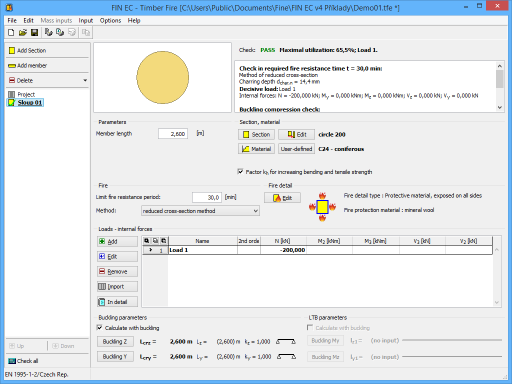Section
Task type "Section" is suitable for the fast verification of the timber cross-section, that is loaded by unlimited number of loads. General work with particular tasks of the project (addition, manipulation) is described in the chapter "Tree menu".
 Section verification
Section verification
The window contains these parts:
Parameters
The member length that is used in buckling and lateral torsional buckling verifications.
Fire
The design method and required time of fire resistance can be specified in this part. The value defined in the main application screen is used as a default.
The design procedure can be selected in accordance with chapter 4.2 of EN 1995-1-2. Available are "Reduced cross-section method" and "Reduced properties method". Recommended procedure is the "Reduces cross-section method" according to the standard. Both procedures are described in the chapter "Methods for fire resistance".
Section, Material
Following buttons are placed in this part:
Section |
|
Edit |
|
Material |
|
User defined |
|
The different charring rates are defined for softwood and hardwood in the table 3.1 of EN 1995-1-2. The only exception is the beech that shall be considered as a softwood in accordance with 3.4.2(6). The radio button "hardwood beach"/"other hardwood" takes this rule into account. This setting is available for Dxx timber grades.
tensile and bending strengths can be increased in accordance with the chapter 3.2 of EN 1995-1-1 for cross-section dimensions less than 150mm using factor kh. This rule can be applied using check box "Factor kh for increasing bending and tensile strength". This factor is described in the part "Material characteristics" of the theoretical help.
Fire protection
The fire protection parameters can be specified in this part. The fire resistance parameters are organized in the window "Fire detail" that can be launched by the button "Edit".
Loads - internal forces
This part contains list of loads (combinations of internal forces and moments), that are checked during the verification. Loads can be added in the table using buttons "Add", "Modify" and "Remove". Table shows the most important information for each load (mainly internal forces and result of analysis). Load properties are entered with the help of window "Load edit".
Loads can be also imported from text or *.csv file. This feature can be used for import of large number of loads, that were calculated with the help of another structural engineering program. Import can be performed using window "Load import", that can be launched by button "Import".
Buckling parameters
The buckling parameters can be specified in this part. The parameters are organized into two different directions z and y and can be specified in the window "Buckling", that can be launched by using the buttons "Buckling Z" and "Buckling Y". The main inputs (the buckling length, end conditions, basic length) are displayed on the right side of the buttons. The buckling parameters input is enabled only for tasks with at least one load, that contains compressive force.
LTB parameters
The parameters of lateral torsional buckling can be specified in this part. The parameters are organized into two different directions z and y and can be specified in the window "LT buckling parameters", that can be launched by using the buttons "Buckling My" and "Buckling Mz". The main inputs (the basic length, beam and load types) are displayed on the right side of the buttons. The parameters input is enabled only for tasks with at least one load, that contains corresponding bending moment.
Results
Results of the analysis for the worst load are displayed in the right upper part of the main window. Detailed results for the active load in the loads table can be displayed using button "In detail". These results are displayed in the new window, text in this window can be copied into clipboard using shortcut Ctrl+C and pasted into a document.
Analysis is described in the part "Ultimate limit state" of the theoretical help.